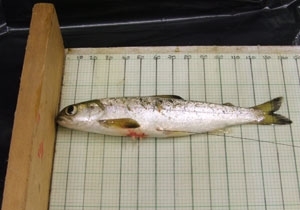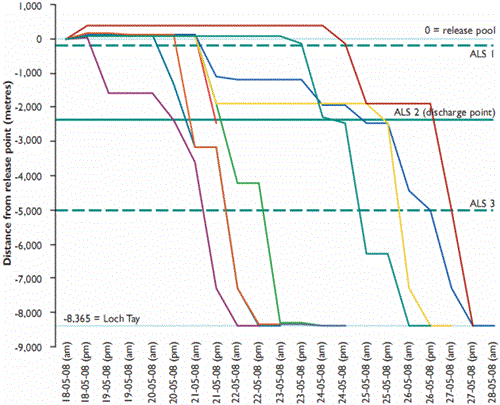 In the spring of 2008, we joined forces with the Tay and District Salmon Fisheries Board to do a pilot study to investigate the impacts of cool water discharge from a Scottish hydro-electric power station on the downstream migration of Atlantic salmon smolts.
In the spring of 2008, we joined forces with the Tay and District Salmon Fisheries Board to do a pilot study to investigate the impacts of cool water discharge from a Scottish hydro-electric power station on the downstream migration of Atlantic salmon smolts.
As salmon smolt migration is triggered by day length and increasing water temperatures in the spring, the concern was that a sudden cold water barrier may restrict their downstream migration and possibly survival. Possible effects on smolt migration may include them not being able to pass through the colder water discharge. This could cause them to be held up for some time in a small area, increasing the chance of being predated. For smolts that do make it through, but have had the timing of their migration hindered and endured increased levels of stress and fatigue, this could affect their survival in the sea and reduce numbers returning as adults.
Our study area was based at the Scottish and Southern Energy hydro power station located on the lower reaches of the River Lochay (Grid ref: NN 545 349), a tributary of Loch Tay. This station is powered by water diverted from storage reservoirs in the neighbouring River Lyon catchment. The water is piped downhill to the power station and then discharged into the River Lochay. Data recorded in previous years has shown that the water temperature at the discharge point can be 9°C lower than in the receiving river during smolt migration.
We used 19 salmon smolts of between 129 mm and 159 mm in length. Each smolt had a radio transmitter (Biotrack Ltd, UK) surgically implanted within the abdominal cavity, with the antenna of the transmitter being left exposed via a small piercing into the body cavity (as shown in the picture above).
Table 1: Time taken by each smolt (in minutes) to pass the 130 metre detection range of ALS 1, 2 and 3
| Smolt |
ALS 1 |
ALS 2 |
ALS 3 |
| 1 |
2 |
265 |
2 |
| 2 |
2 |
161 |
2 |
| 8 |
2 |
36 |
2 |
| 9 |
2 |
- |
- |
| 10 |
6 |
38 |
2 |
| 12 |
2 |
82 |
- |
| 13 |
6 |
25 |
6 |
| 16 |
8 |
- |
2 |
| 17 |
21 |
1039 |
256 |
| 18 |
2 |
220 |
2 |
| 19 |
8 |
177 |
2 |
We released the smolts on 18 May 2008 approximately 2.5 kilometres upstream of the power station. Each smolt was located twice daily (morning and night) using hand-held receivers. We used three automatic listening stations (ALS), placing ALS 1 upstream to signal the beginning of a smolt migratory movement, ALS 2 at the discharge point to record smolts approaching and passing through the cold water and ALS 3 downstream, 3,345 metres above Loch Tay. The total journey to Loch Tay was 8,365 metres from the initial release point.
Of the 19 smolts released, nine (47%) passed the hydro discharge point successfully (see Figure 1). The remaining 10 were recorded either as dead (one smolt), missing − either because of tag failure or predation (five smolts), or did not migrate from the release site during the two-week tracking period (four smolts).
Figure 1: Movements of the nine salmon smolts tracked from the release pool, past the discharge point and into Loch Tay

The 0 point on the y-axis represents the tagged smolt release point. The solid bar (at 2,485 metres) represents the hydro discharge point and ALS 2. The two dashed lines situated at 145 metres and 5,020 metres indicate the positions of the ALS 1 and ALS 3. Loch Tay starts at 8,365 metres from the release point.
The migrating smolts generally moved quickly past both the upstream (ALS 1) and down stream (ALS 3) loggers. However, they took considerably longer to migrate past the logger at the discharge point (ALS 3) as shown in Table 1.
This pilot study suggested that the cold water discharge from the power station could be delaying the downstream progression of migrating salmon smolts in the River Lochay. However, there was no evidence of increased mortality due to the delay, and eventually smolts passed through the discharge and continued their downstream migration successfully reaching Loch Tay.
Although, the results from this initial first year study show that the power station could be negatively effecting the successful migration of the salmon smolts, no firm conclusions can be made from one year’s data. These results will benefit from repeat studies in the near future and could potentially confirm the real impacts of hydro-electric power stations. Possible future conclusions from this study could lead to fish-friendly designs being implemented into the construction of new hydro-electric power stations.